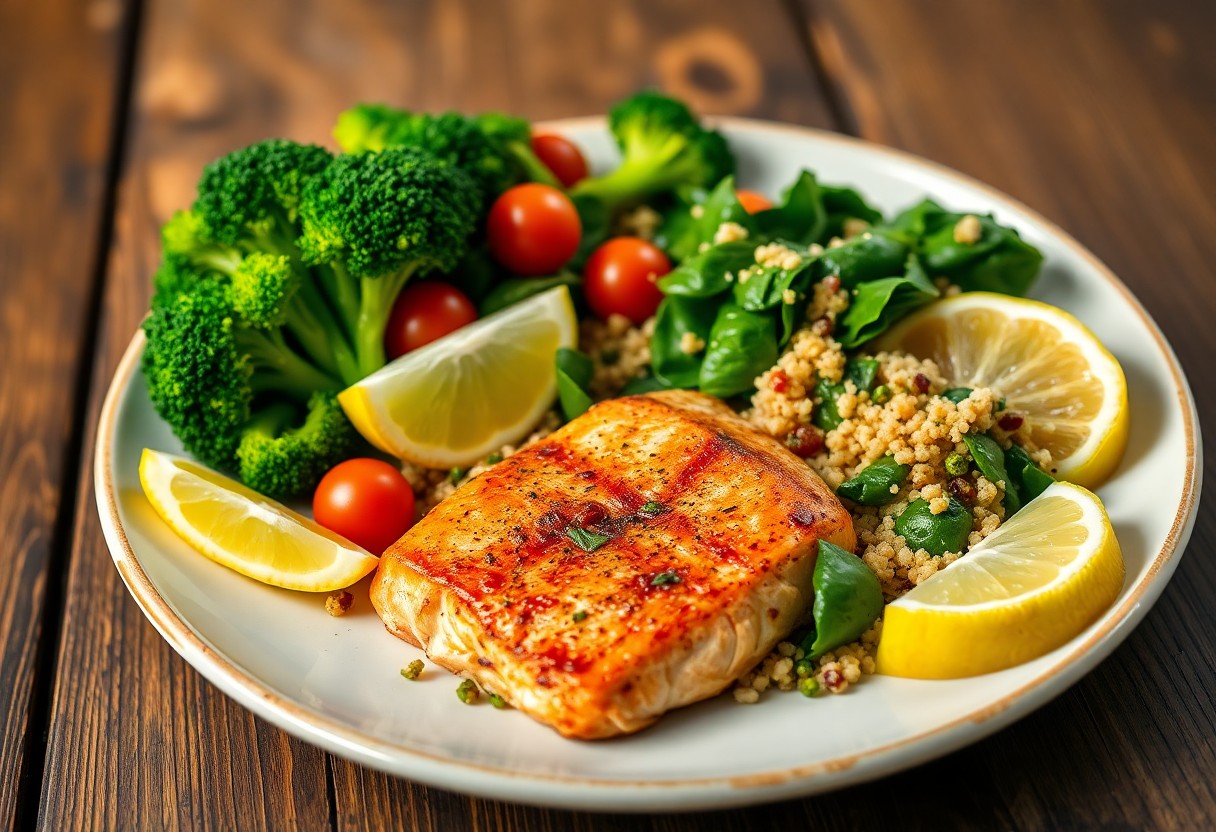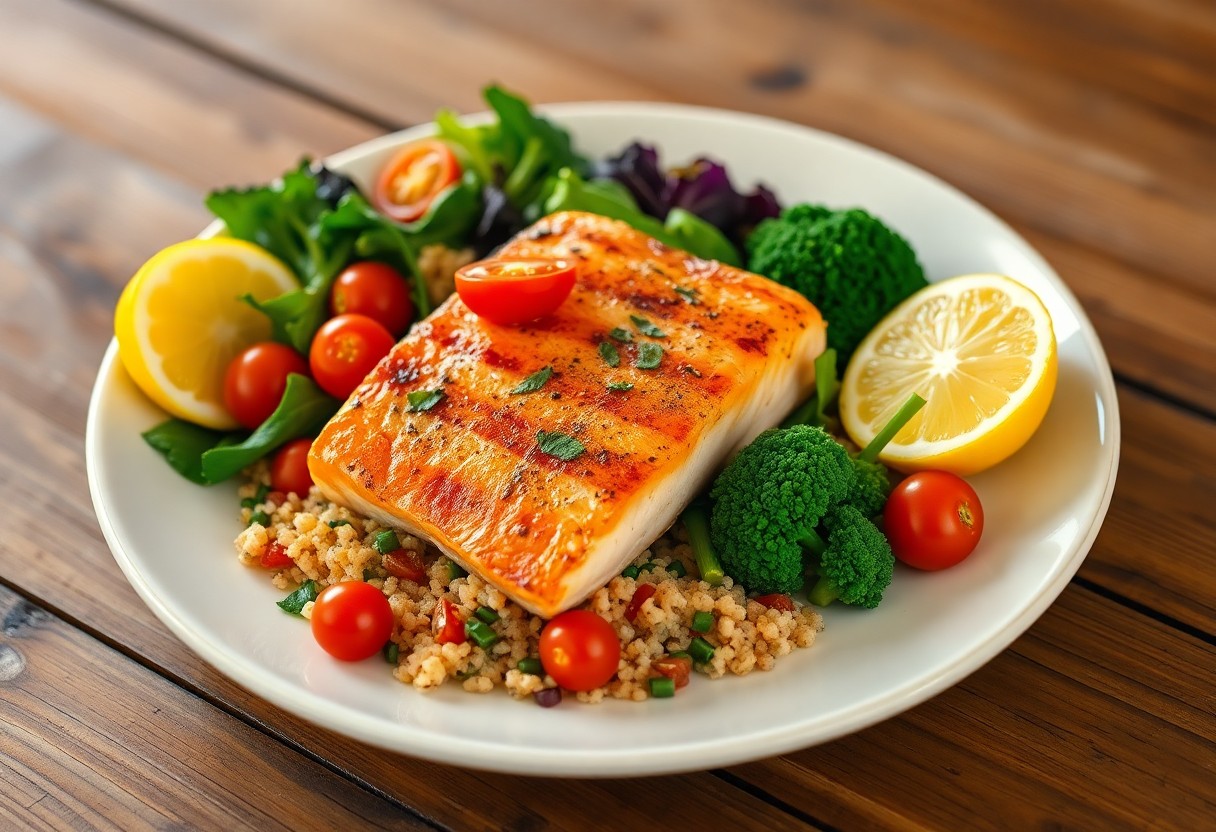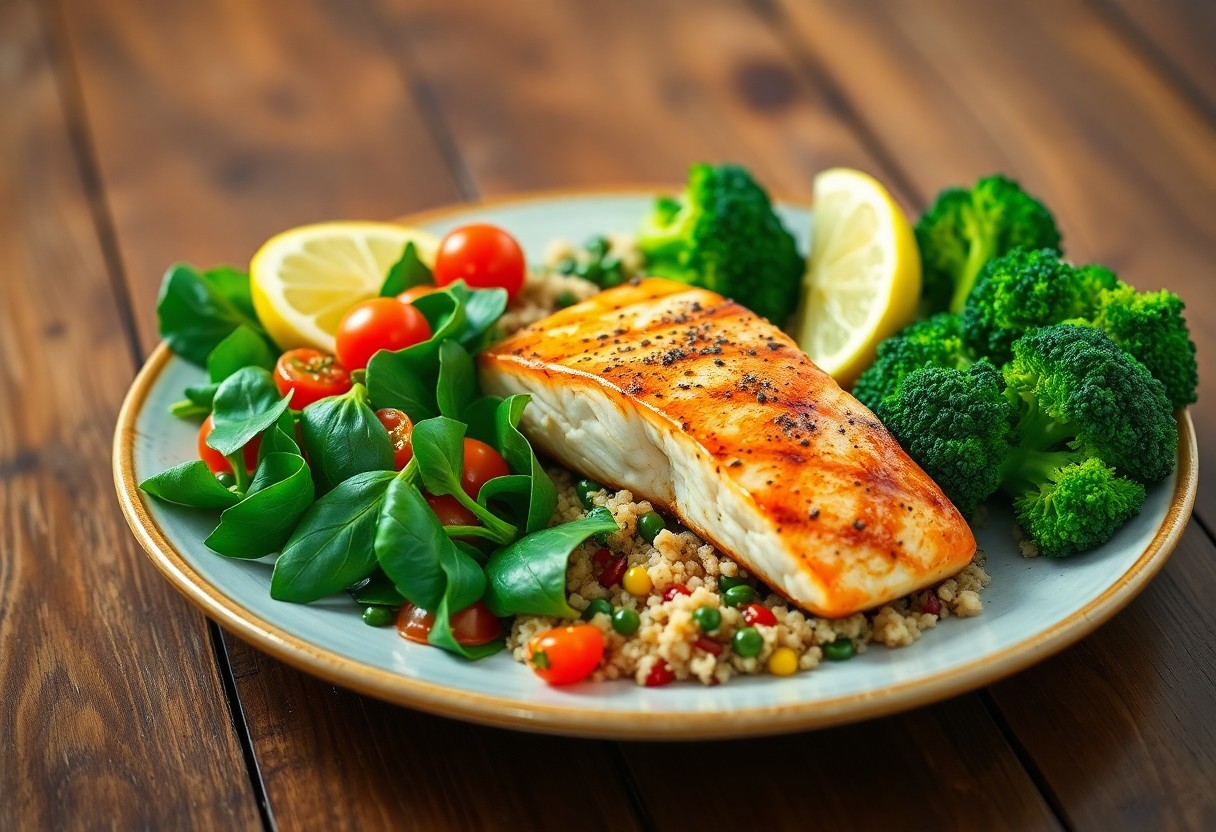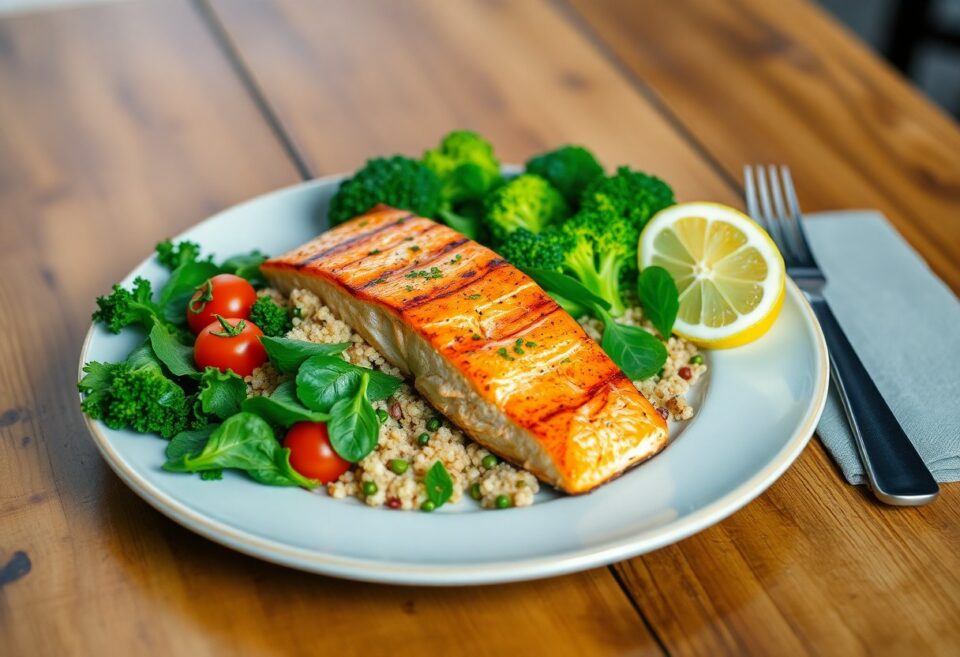Over the years, you’ve likely realized how challenging it can be to prepare nutritious meals quickly after a busy day. With a focus on efficiency and health, these recipes enable you to enjoy delicious, balanced dinners in just 20 minutes. By choosing the right ingredients and techniques, you’ll maintain flavor without sacrificing your wellness goals. Explore a variety of options that fit your lifestyle and avoid unhealthy takeout alternatives. For even more ideas, check out Under 20-minute recipes that keep your evenings stress-free.

Flavor-Packed Proteins in Record Time
Quick-Cooking Proteins: Chicken, Fish, and Tofu
You can shave minutes off your dinner prep by choosing proteins that naturally cook fast without sacrificing flavor or texture. Boneless, skinless chicken breasts or thighs, for instance, reach a safe internal temperature in about 10 to 12 minutes when pan-seared over medium-high heat. Chicken thighs offer more fat and flavor, which helps keep the meat juicy even with the shorter cooking time. For fish, options like salmon, cod, or tilapia typically cook through in under 8 minutes. Thin fillets work best, allowing the flesh to remain tender and flaky rather than overcooked. Tofu, especially the extra-firm variety pressed and sliced thinly, sizzles quickly and soaks up marinades in minutes, turning crispy on the outside in about 6 to 8 minutes when pan-fried.
To maximize your efficiency, slice chicken or tofu into thin strips or small cubes; smaller pieces drastically reduce cooking time and boost surface area for caramelization and flavor binding. Fish fillets, when cooked skin-side down first, develop a golden crust that locks in moisture, leading to better mouthfeel and presentation. While these proteins cook rapidly, pairing them with quick-steamed veggies or a fresh salad completes your meal without long wait times, confirming why these options dominate 20-minute dinner menus.
Marinades and Seasonings that Elevate Flavors
Simple marinades constructed from pantry staples can transform your proteins within minutes instead of hours. An acidic component like lemon juice or vinegar breaks down muscle fibers slightly, enhancing tenderness. Combine this with herbs such as rosemary or thyme, garlic, and a splash of olive oil, and you craft layers of flavor that penetrate the protein quickly. Investing 5 to 10 minutes in a marinade while prepping other ingredients can make a remarkable difference in the final taste profile.
Spices also play a key role in elevating rapid-cook proteins; a rub made with smoked paprika, cumin, and black pepper adds deep, smoky notes without requiring extra cook time. You might also try a quick soy sauce and ginger marinade for a dash of umami and heat. Pre-mixed seasoning blends designed specifically for speedy cooking, like Cajun or za’atar, can be sprinkled directly on your protein just before it hits the pan.
Exploring acid-base balance in your marinades intensifies complex flavor development—you might mix lime juice with a touch of honey and crushed red pepper to offer both brightness and subtle sweetness alongside heat. This kind of thoughtful seasoning strategy unlocks gourmet-quality profiles in no time, proving that speed doesn’t have to mean blandness in your healthy dinner routine.
Vibrant Vegetables: Quick Prep and Cook Methods
Rapid Roasting and Sautéing Techniques
Roasting vegetables at a high temperature—typically around 425°F (220°C)—creates a beautiful caramelization that deepens their natural sweetness and enhances texture. Cut vegetables into uniform pieces about 1-inch in size to ensure even cooking within 15-20 minutes. You can toss broccoli florets, bell pepper strips, and cherry tomatoes with just a tablespoon of olive oil and a pinch of salt for a simple yet delicious side that requires minimal effort. Sautéing, on the other hand, works exceptionally well for thinner, quicker-cooking veggies like zucchini noodles, snap peas, and baby spinach. A hot pan with a small amount of avocado oil can get your vegetables tender and lightly crisp in under 10 minutes, preserving both flavor and nutrients.
Both roasting and sautéing offer the flexibility to customize the cooking experience based on your schedule. Roasting gives you the advantage of letting the oven do the work while you focus on preparing other components of your meal. Alternatively, sautéing allows for quick adjustments in heat and seasoning, delivering a fresher, less cooked finish that highlights the vegetable’s inherent qualities. Combining these techniques in one meal can give your plate contrasting textures and maximize the variety of vitamins and minerals you consume.
Flavor Boosters: Herbs and Spices for Vegetables
Add complexity and freshness to your vegetables by incorporating herbs like thyme, rosemary, and basil during cooking. These aromatic herbs infuse roasted carrots or sautéed mushrooms with exquisite depth, elevating them beyond simple sides. Spices such as smoked paprika, cumin, and turmeric can introduce warm, earthy undertones that complement the natural sweetness of vegetables while also contributing antioxidants and anti-inflammatory benefits. Grinding some black pepper or sprinkling chili flakes can briefly spark your palate, especially when paired with cooling herbs like cilantro or parsley as a finishing touch.
Cultivating a mini-herb garden or stocking your pantry with an assortment of dried spices allows you to experiment with endless combinations, tailoring each meal to your mood and dietary goals. A dash of lemon zest or a spritz of balsamic vinegar right before serving can brighten even the most humble vegetable medley, making healthy eating something you look forward to every day.
Herbs and spices not only transform the flavor profile but also contribute to your overall health. Rosemary contains carnosic acid, which supports brain health, while turmeric’s curcumin offers potent anti-inflammatory properties, making your quick vegetable dishes not just tasty but also functional. By layering these seasonings throughout the cooking process—from initial roasting to final garnishes—you tap into a well of culinary creativity that makes your 20-minute dinners both vibrant and nourishing.
Grain Bowls Reimagined: A Wholesome Base
Transforming your dinner into a vibrant, nutrient-packed grain bowl doesn’t need to be time-consuming. The base plays a pivotal role in establishing both texture and flavor, setting the stage for the whole meal. Opting for whole grains or their quicker-cooking alternatives adds a complex carbohydrate element that fuels your body and keeps you satisfied through the evening. You might typically reach for basic rice or pasta, but exploring an array of grains not only diversifies your palate but also amps up the nutritional value significantly.
The versatility of grain bowls allows for easy customization by mixing and matching different grain bases with an array of healthful ingredients. You can adjust ratios, add herbs, or toss in toasted nuts right into the bowl base, elevating both taste and texture without extending your preparation time. This approach turns a simple dinner into a colorful nutritional powerhouse packed with vitamins, minerals, and fiber that support digestion and sustained energy.
Speedy Grains: Quinoa, Couscous, and Rice Alternatives
Quinoa stands out as a powerhouse grain alternative, boasting all nine important amino acids and a cook time of roughly 15 minutes, making it one of the fastest whole grains you can prepare. Couscous, especially the instant variety, cooks in as little as 5 minutes and offers a light, fluffy texture perfect for absorbing dressings and sauces. If pasta feels more familiar, consider brown basmati rice or the newer quick-cook “minute rice” options, which shorten cooking times to under 10 minutes without sacrificing too much nutritional quality.
Exploring other alternatives like bulgur or farro can add variety, but their cooking times typically stretch beyond 15 minutes, so pre-soaking or using canned versions can help you maintain the 20-minute dinner window. Also worth considering are cauliflower rice or shredded zucchini as grain substitutes; while not grains, they provide a low-calorie, fibrous base that pairs wonderfully with bold toppings and sauces. These options cater perfectly to those looking for lower-carb or gluten-free bases without compromising on volume or mouthfeel.
Creative Toppings for Nutrient-Dense Bowls
Layering your grain bowl with thoughtfully chosen toppings drastically increases its nutrient density while creating a dynamic flavor profile. Incorporate a mix of roasted vegetables such as sweet potatoes or Brussels sprouts for caramelized sweetness coupled with a satisfying crunch. Fresh vegetables like cucumber, cherry tomatoes, or shredded kale add crispness, while fermented options such as sauerkraut boost gut health with probiotics. For protein, try grilled chicken, chickpeas, or a soft-boiled egg to keep the meal balanced.
Incorporate healthy fats by sprinkling toasted seeds like pumpkin or sunflower, or adding a drizzle of extra virgin olive oil or tahini. Herbs like cilantro, mint, or parsley not only brighten the dish visually but also enhance antioxidant intake. Tossing in a small handful of nuts or a spoonful of avocado can improve the absorption of fat-soluble vitamins from the veggies, maximizing the nutritional impact of your bowl.
The beauty of creative toppings lies in their adaptability to your pantry and preferences. You can combine a handful of avocado slices with chopped roasted beets and a sprinkle of hemp seeds for an omega-3 boost, or go for a Middle Eastern flair with spiced chickpeas, pickled onions, and a dollop of hummus. Each addition layers flavor, color, and vital nutrients that transform a straightforward grain bowl into an exciting, healthful culinary experience tailored just for you.

One-Pan Wonders: Simplifying Cleanup
Balanced One-Pan Recipes for Busy Nights
One-pan meals streamline dinner in a way that not only saves prep time but also minimizes cleanup without sacrificing nutrition. Opt for combinations like chicken thighs with sweet potatoes and green beans, all roasted together with a drizzle of olive oil and herbs. These meals ensure you get a balance of lean protein, complex carbohydrates, and fiber-rich vegetables, which supports sustained energy levels and digestive health. By layering ingredients with varied cook times smartly—such as placing denser root vegetables at the bottom and quicker-cooking greens on top—you let the oven do the work efficiently.
For a quick, balanced dinner, try a sheet pan salmon with asparagus and cherry tomatoes. The omega-3 fats from salmon enhance heart health, while the veggies offer antioxidants and vitamins. You can mix seasonings like smoked paprika and garlic powder to introduce depth without extra effort. This kind of meal is ideal for hectic evenings when simplicity is key, yet you still want to put something wholesome on the table.
Smart Ingredient Choices to Maximize Flavor
Using smart ingredient pairings elevates your one-pan recipes beyond mere convenience. Aromatics such as garlic, shallots, and fresh herbs release their crucial oils when roasted, infusing every component with deep flavor. Acidity from a squeeze of lemon or a splash of balsamic vinegar before serving brightens the entire dish, preventing it from tasting flat or heavy. Don’t underestimate the power of texture either—adding nuts or seeds as a garnish creates satisfying contrast.
Root vegetables like carrots and parsnips provide natural sweetness that balances savory elements, while spices like cumin or smoked paprika introduce warmth and complexity. Layering these complementary flavors directly in the pan means you build a more dynamic dish with less effort. Consider adding a handful of cherry tomatoes towards the end of cooking to maintain their juiciness and pop of freshness, enhancing both taste and appearance.
Incorporating fermented ingredients like miso or a dollop of yogurt can add umami richness and tenderize proteins subtly during cooking. Another tip is to toast spices briefly in the pan before adding other ingredients; this releases their oils and unlocks deeper aromas which permeate the whole meal. These strategies help you maximize flavor on busy nights without resorting to complicated techniques or extended cooking times.

Time-Saving Hacks for Busy Cooks
Meal Prep Strategies for Weeknight Efficiency
Batch-cooking grains like quinoa, brown rice, or farro on the weekend can cut down your active cooking time during the week dramatically. Having a ready-to-use base allows you to throw together meals quickly by adding fresh veggies and your choice of protein. Pre-washing and chopping vegetables such as bell peppers, carrots, or broccoli ahead of time also streamlines the process, so your dinner comes together in less than 20 minutes without scrambling. Investing a little time prepping ingredients upfront can help you assemble meals effortlessly during hectic evenings.
Another approach is to assemble complete meal kits in advance. Store all the components for a dish in a single container—protein, sauce, and vegetables—so all that’s left is cooking or reheating. For example, marinating chicken breasts and bagging them with sliced zucchini and a drizzle of olive oil means you only need to fire up your skillet once it’s dinnertime. For more inspiration, explore 28 Healthy Dinner Ideas Ready in 20 Minutes Max to see how you can transform simple ingredients into quick, nutritious meals.
Essential Kitchen Tools that Cut Cooking Time
Equipping your kitchen with the right tools can drastically reduce the time you spend preparing dinner. A sharp chef’s knife, for example, won’t just speed up chopping but also ensures safety and precision. Consider investing in a mandoline slicer; it can shave vegetables in seconds, producing uniform cuts for even cooking. Non-stick pans heat quickly and require less oil, which saves both time and calories when searing proteins or sautéing vegetables.
Electrical appliances like an Instant Pot or a high-quality blender can be game changers. An Instant Pot compresses cooking time by combining pressure cooking with sautéing, bringing dishes like stews or chicken thighs to the table fast. A powerful blender speeds up making sauces, dressings, or even healthy soups, turning fresh produce into smooth, ready-to-use ingredients in less than a minute.
Beyond these crucial tools, consider multitaskers that combine functions, such as a food processor. They handle chopping, shredding, and mixing in one go, cutting down your hands-on time significantly. A reliable digital timer helps you keep precise track of cooking durations, preventing overcooking or burning, which often leads to unnecessary repeat efforts. Having these savvy gadgets ready and within reach empowers you to whip up your favorite healthy dinners swiftly, even on the busiest nights.
Summing up
As a reminder, preparing healthy dinner recipes in 20 minutes is entirely achievable when you prioritize simple, nutrient-dense ingredients and efficient cooking methods. By focusing on fresh vegetables, lean proteins, and whole grains, you can create meals that satisfy both your taste buds and your nutritional needs without spending excessive time in the kitchen. This approach not only supports your overall well-being but also encourages consistent healthy eating habits even on your busiest days.
You have the ability to make quick, wholesome dinners a regular part of your routine by keeping your pantry stocked with versatile staples and planning ahead minimally. Embracing these strategies empowers you to enjoy delicious, balanced meals while maintaining control over what you eat, making it easier to stay on track with your health goals. Ultimately, mastering healthy dinner recipes in 20 minutes benefits you by saving time and promoting a lifestyle that prioritizes your vitality.
FAQ
Q: What are some quick protein options for a healthy dinner in 20 minutes?
A: Quick protein options include chicken breast, shrimp, eggs, tofu, canned beans, and fish like salmon or tilapia. These ingredients cook fast and provide imperative nutrients for a balanced meal.
Q: How can I incorporate more vegetables into a fast dinner recipe?
A: Use pre-washed or frozen vegetables to save prep time, and consider stir-frying, steaming, or roasting them quickly. Adding leafy greens, bell peppers, zucchini, or cherry tomatoes can enhance flavor and nutrition with minimal cooking time.
Q: Are there any healthy side dishes that can be prepared quickly?
A: Yes, simple salads with mixed greens and vinaigrette, quinoa or couscous (which cooks in under 15 minutes), and steamed or roasted vegetables are excellent fast side dishes that complement a healthy dinner.
Q: Can I make healthy dinner recipes suitable for meal prepping in 20 minutes?
A: Absolutely. Opt for one-pan recipes or batch-cook ingredients like grains and proteins, then mix and match them through the week. Quick stir-fries and sheet-pan meals can also be doubled to create multiple servings.
Q: What cooking techniques help reduce dinner preparation time without sacrificing nutrition?
A: Techniques such as sautéing, stir-frying, grilling, and steaming retain nutrients and cook food quickly. Using tools like pressure cookers or microwaves can further speed up the process while maintaining a healthy meal.
Q: How can I ensure my 20-minute dinner recipes are balanced and nutritious?
A: Aim to include a source of lean protein, a variety of colorful vegetables, and whole grains or healthy fats in your meal. Planning recipes ahead and keeping staples on hand supports quick assembly of balanced dinners.
Q: What are some examples of flavoring options that keep dinners healthy but exciting?
A: Use fresh herbs (like basil, cilantro, or parsley), spices (such as cumin, paprika, or turmeric), citrus juice, garlic, ginger, and low-sodium sauces like soy or tahini. These ingredients add flavor without extra calories or unhealthy additives.
